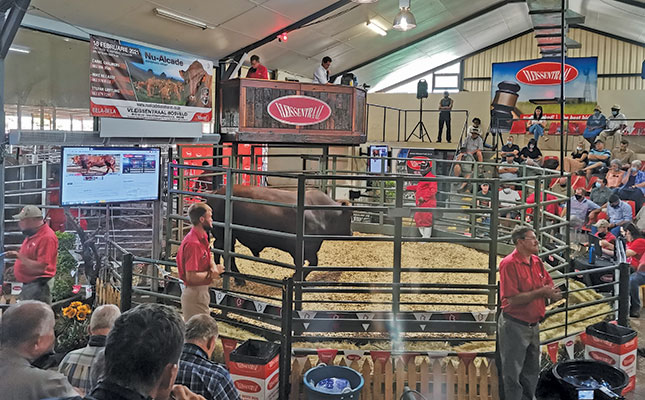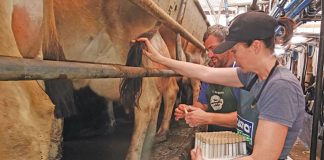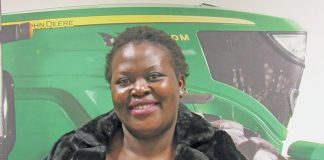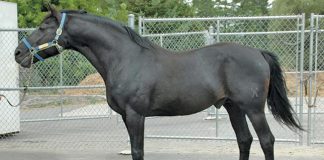
Photo: Supplied
Auctions present an easy option for farmers who have surplus animals to sell or have no agreements with buyers. They also give a true reflection of what the market is willing to pay at any given time, and money and animal transfers are done on the same day.
Animals can be sold at a private or public auction, with the number of animals involved and the value of the animals being the main determinant of where they should be sold.
Cornel Landman, owner of Karoo Lusern, regularly buys and sells animals at auctions in the Klein Karoo.
“I buy most of the livestock we finish in our feedlots directly from farmers. But I still go to auctions at least twice a month to get a feel for the market, network with buyers and sellers, and support the local farming industry by purchasing livestock from smallholder farmers. Their only means of selling livestock is at auctions.
“When auction volumes are low, the auctioneers often ask me to supply the auction with additional animals to increase auction numbers, which I happily do if my livestock numbers allow,” he says.
Private auctions are usually hosted once a year, with the animals of only one seller or group of sellers being on offer. Public auctions, in contrast, are held weekly or monthly, with schedules being available from auction houses.
Hosting a private auction can reduce transport costs if the auction is hosted on the farm, but it adds other costs, as the farmer needs to set up amenities and facilities to host the event.
Anton Vos, managing director of Vleissentraal, says this can be overcome by making use of the facilities of the auctioning company, but it adds the challenge of moving a large number of livestock.
Commission charged on public sales averages around 8%, depending on the auction company, while it may be negotiated down to about 5% for a private auction.
Any auctioneer might conduct a public auction, whereas sellers can request whom they want to use at a private auction. Vos explains that sellers normally prefer an auctioneer who specialises in their specific breed of animal when they want to auction off stud animals.
Public auctions
Sellers can arrive with their animals at a public auction without making prior arrangements, but Vos says this might not always result in the best prices.
“Auction companies will always try to accommodate drop-ins, but registered sellers are better off, as they’ll benefit from the auction agent’s advice. These agents have extensive market knowledge and regularly visit sellers on their farms to offer advice on which animals to send, which to hold back, and which categories to target, regardless of the size of the farming operation.”
Classification is determined by the animals’ age, fatness, conformation, damage and sex, with A-grade and B-grade animals that are healthy, castrated and having little fat fetching significantly higher prices than AB grade. C-graded animals fetch the lowest prices.
Most farmers sell their cattle for finishing after weaning at six to seven months of age. Vos explains that weaners with a weight of 180kg to 230kg currently trade at about R40/ kg, whereas those weighing 230kg to 280kg trade for roughly R2,50/kg less, and those that weigh more than 280kg trade for R3/kg less than those in the 230kg to 280kg category. The price fetched for old cows is significantly lower.
The same applies to sheep, with 26kg being the ideal weight. “Buyers of finishing animals need to add value to the animals by finishing them off. At a weight of 26kg, buyers have the ability to double their value,” says Vos.
Some buyers prefer certain breeds of livestock over others, and dehorned and polled cattle usually fetch higher prices than horned animals.
Animals may be sold individually or in batches. Landman says sellers often think they will make more money by selling livestock individually.
“While this might be true for stud animals, buyers tend to evaluate individually sold animals more closely, which in the end could count against the animals.
“With groups of animals, in contrast, less emphasis is placed on individual traits, as the group is evaluated as a whole, which might lead to a better overall evaluation.”
Prior arrangements
By law, animals have to be marked for traceability and identification purposes, and cannot be sold at an auction without these marks. This helps to prevent trade in stolen animals and to trace animals should there be a disease outbreak.
Sellers are responsible for getting their livestock to the auction venue, but agents may help with these arrangements. They may also help to link farmers in the same vicinity to share transport, which could help reduce costs. The key here is to use a clean vehicle with good airflow, and not to overcrowd the animals.
According to the Animal Identification Act of 2002, movement permits have to be completed by the owner to prove that the animals were not stolen and to trace the movement of animals in the event of a disease outbreak. Article 8 documents must also be completed if the animals are transported by a third party; these documents give permission to the third party to transport the animals.
Buyers also have to complete forms after the auction to allow them to take the animals home. Vos says these documents can be obtained from the auction house, the Red Meat Producers’ Organisation, or the Stock Theft Unit of the South African Police Service.
At the auction, the seller has to fill out the acknowledgement of receipt form, supplying his/her name, address, ID number and stock identification details. Sellers also have to fill in a form declaring that the animals are healthy, and reveal any diseases they were previously treated for.
Animals not accompanied by veterinary certificates confirming their negative foot-and-mouth disease (FMD) status will be inspected at the auction site in a separate area before being allowed into the auction pens.
“Animals in poor condition are evaluated on the transport chart and sent straight home if found to be ill,” says Vos.
Foot-and-mouth disease limitations
Farmers residing in FMD-controlled areas, called infected and protection zones, are only allowed to attend auctions in those zones. To buy animals in a protection zone and move them to a disease-free area requires a veterinary evaluation and the necessary Red Cross permits, and the movement of these animals that tested negative must be done in a sealed truck.
“We don’t advise the movement of an animal out of an FMD area, as the biosecurity risk is just too great,” says Vos.
Animals remain the seller’s responsibility until the hammer has closed a sale. Once the auction has ended, the auction house draws up an account statement for the seller, who has to ensure that all the particulars are correct and accept payment.
Buying
The greatest advantage of buying at an auction is that buyers can see dozens of animals from different sellers and then choose the lots they are most interested in. In contrast, if they buy directly from a farmer, their options are limited to the animals available on the farm.
While auctions are hosted weekly across the country, Landman generally prefers to buy animals at auctions within his region. This not only helps to limit transportation costs, but ensures that the animals are well adapted to the production conditions of his farm.
Farmers generally look further afield when they want to introduce new genetics to their herds or flocks that may not be available in their region.
To register as a bidder, a buyer has to provide auctioneers with an original identity document or passport, proof of address in the form of an account that is less than three months old, and a copy of his or her VAT registration certificate, if applicable. If the buyer represents a business, the registration documents, original identity documents and proof of address of the directors/members of the business are required.
A person appointed to purchase animals on behalf of someone else has to furnish the auctioneer with a signed power of attorney, otherwise the person could be held personally liable for the purchases made.
Registration can be done within an hour, and Vleissentraal usually uses this as an opportunity to check on the credibility of a buyer, according to Vos. Once registered, the bidder receives a unique client number that is usually valid for future auctions of specific companies in specific regions. With Vleissentraal, for example, different numbers are used as identifiers for different branches of the company.
Some auctions require a refundable deposit, but Vos says that this is not normal practice with most of the livestock auctions he is familiar with.
Presenting the animals
When the animals are presented to the public, anybody registered as a bidder can make an offer. The animals usually go to the bidder who makes the highest offer, provided that the offer is above the reserve price (the price set by the owner as the minimum he or she is willing to accept).
Buyers should familiarise themselves with the animals and lots before placing bids, stresses Vos.
“Go and look at the animals beforehand to see if they meet your expectations. If you’re buying stud animals, get hold of their performance and health records.”
Also, look at whether the animals are presented in batches or as individuals. “Mostly, we have batches of 10 animals, with the price being established per animal. People might then end up thinking they bought the whole batch for R10 000, when in fact they have to take the batch for R100 000.”
Prices may be subject to VAT if the seller is registered for VAT. Buyers, in effect, need to pay the total cost of a group, plus the 15% VAT.
Vos advises first-timers to look at what other buyers are doing to get a feel for the process. Buyers should be quiet during the auction to avoid any misunderstanding.
“If you answer your phone or talk to someone sitting next to you with big hand gestures, the auctioneer might interpret that as a bid, and you could be liable if it is accepted,” says Vos.
Most auction houses have card facilities and accept cash and EFTs. Animals are released to the buyer as soon as the payment has cleared. Buyers should preferably remove their animals the same day.
“Leaving the animals overnight poses a risk of theft. Most auction houses will assist in supplying the animals staying over with food and water, but this responsibility shifts to the buyer once the bid is accepted,” says Vos.
Buyers should talk to the auction agent if the animals are to be left at the venue overnight or if they need help with organising transport.
For biosecurity reasons, new animals should be kept separate on the buyer’s farm for observation for up to four weeks before being introduced to the existing flock or herd.
Email Cornel Landman at [email protected], or Anton Vos at [email protected].











